Example of use
Recording Steps

S1: Describing the situation when you experienced strong negative feelings.
In initial screen of the app, tap the add button and a new window will appear on the screen. In this window you must enter a name for the episode, the date the episode occurred and the time of day. The next figure shows this already completed window:
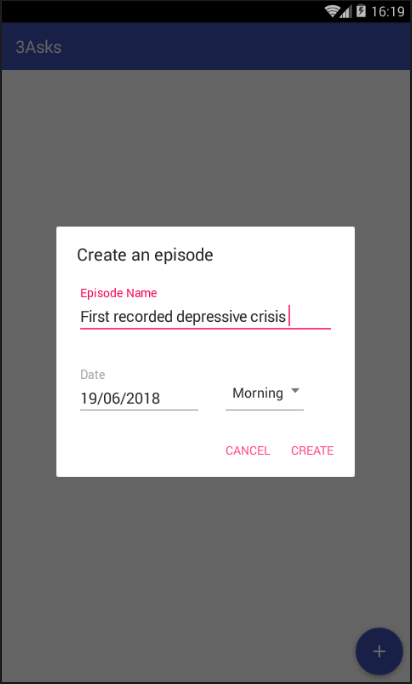
At the end, you only have to confirm the creation of the new episode by clicking the create button.
After the episode is created, a new window will open, the edit window of the episode details. This window, more specifically the When tab, corresponds to the When question. In this screen you can change the details of the episode and specify a detailed description of it in the field Description.
Remember that you should describe the situation in which you experienced negative feelings as you were a camera, just record the facts. You should not record your thoughts, justifications or judgments about who is responsible. This will be done in the next steps. The next figure shows this already completed window:
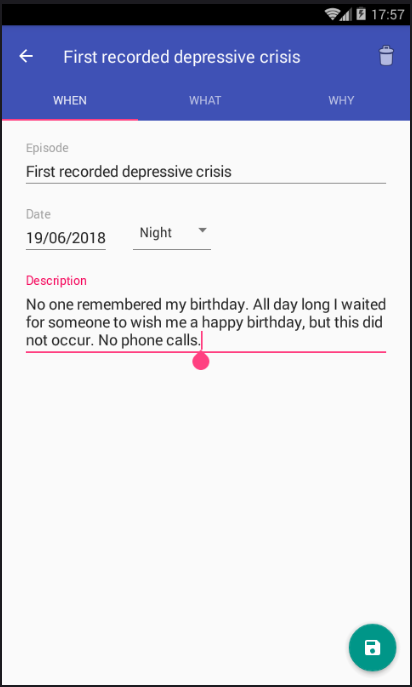
After any modification or completion of episode details, click the save button in the When tab.
S2: Write down your feelings and actions/behavior.
Go to the next tab in app, the What question. Now, You must enter the reactions (feeling, physical sensation or action) faced in the episode. To insert a reaction, click the add button in What tab and a new window will appear. In this window, you will enter your reaction and choose a type for it. The next figure shows this already completed window:
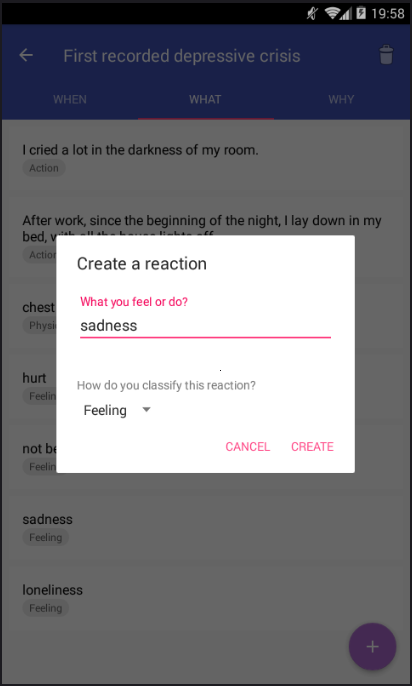
After entering your reaction, confirm the creation by clicking the create button. Note the reactions recorded in our example in the following figure:
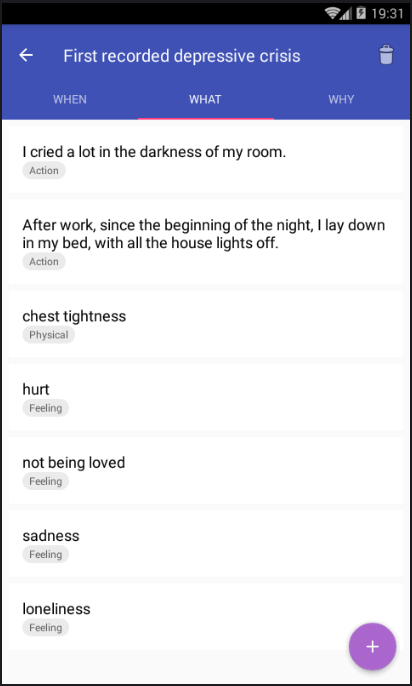
You can add as many reactions as you want, but the important thing is to register the strongest reactions. Don't worry if you don't remember them all.
S3: Register your thoughts and beliefs.
Go to the next tab in app, the Why tab. In this step, which comprises the first part of the Why question, bearing in mind the negative situation and your reactions experienced in it (you can go back to the When tab to review the episode and the What tab to review your reactions), you should try to identify which thoughts and beliefs were on your mind in this situation.
"What was I thinking?" and "Why I experienced this reaction?" are the central questions. Remember my tip: use your feelings, when you come to the thought that triggered a reaction, you will feel an unpleasant feeling.
To add a new belief, go to the Why tab and click the add button. A new window will open. This window is illustrated in next image:
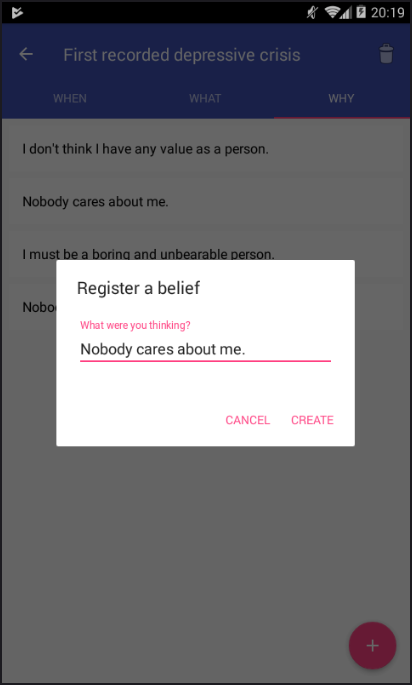
After entering the new belief, confirm the creation by clicking the create button. Note the beliefs recorded in our example in the following figure:
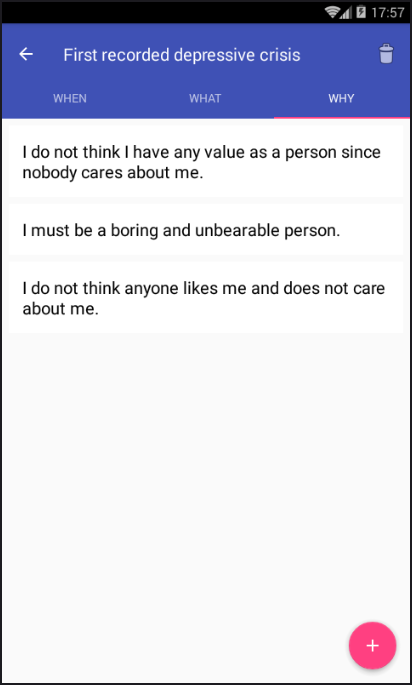
Again, it is not necessary to record all thoughts and beliefs. The most important thing is to record the beliefs that caused your strongest reactions.
S4: Classify your negative beliefs into categories.
After remembering your beliefs, you should categorize them according to unhelpful thinking styles. Choose one of your beliefs and click on it. A new screen will appear with 3 tabs: Details (which stores the details of your belief), Arguments (which stores the evidence in favor of your belief) and Objections (which stores evidence contrary to your belief).
Again, it is not necessary to record all thoughts and beliefs. The most important thing is to record the beliefs that caused your strongest reactions.
To classify your belief, go to the Details tab. The available unhelpful thinking styles are grouped as buttons. To select in which your belief fits, just click on the corresponding button and it will be selected. You can select as many buttons as you want. The next figure shows an example of the Details tab:
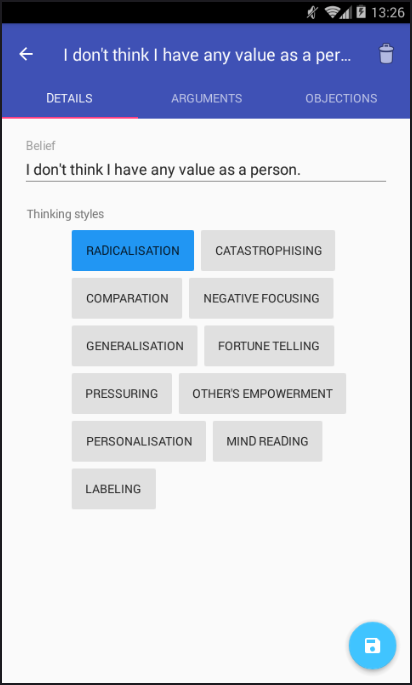
You can also deselect a button by clicking it again. In this tab you can also change your belief. After making the desired changes, be sure to click the save button in this tab.
Next, you will be able to observe the unhelpful thinking styles of each belief in our example and the reasons why each style was selected.
Belief: I don't think I have any value as a person.
>>> Radicalisation: even if you do not have a hectic social life, you have other qualities and can be successful in other areas such as your professional life.
Belief: Nobody cares about me.
>>> Catastrophising: it's not because people have not wished you a happy birthday that no one cares about you.
>>> Mind reading: you think you know what others think and feel about you, but that is impossible. People often have difficulty expressing their feelings, so someone you think does not care about you can care a lot.
Belief: I must be a boring and unbearable person.
>>> Personalisation: probably people did not wish you a happy birthday because they were busy with their lives, facing the problems of the day-to-day that we all have. It is impossible to conclude that this is 100% your fault.
>>> Mind reading: you think you know what others think and feel about you, but that is impossible. To be sure you should ask people what they think and feel about you.
>>> Labeling: you are categorizing yourself based on a single event.
Belief: Nobody likes me.
>>> Catastrophising: it's not because people have not wished you a happy birthday that no one likes you.
>>> Mind reading: you think you know what others think and feel about you, but that is impossible. People often have difficulty expressing their feelings, so someone you think does not like you can like a lot.
S5: Challenging your unhelpful thoughts and beliefs.
Now is the time to dialogue with your beliefs. Go to the Arguments tab to specify the evidence in favor of your belief. "Was it something that happened in the past?" is the key question to identify the arguments in favor of this belief or thought.
To add a new argument, go to the Arguments tab and click the add button. A window will open for you to enter your argument. After typing, confirm the creation of the argument by clicking the create button.
To modify or delete an argument, simply click on it and modify it or delete it through the window that will open. The next figure shows an example of the Argumets tab.
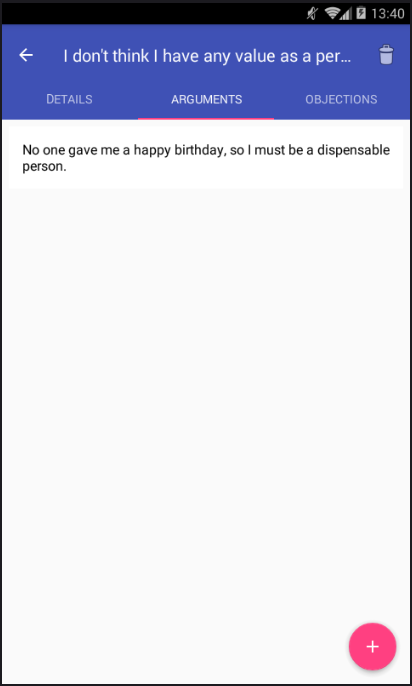
On the other hand, go to the Objections tab to specify the evidence contrary to your belief. "Are the arguments in favor of this belief realistic?", "Has any fact or situation ever occurred in opposition to this thought?", "If a friend confess to having this thought or belief in the same situation, would you agree to this thought? If not, why?" are the key questions to identify the objections to this belief or thought.
To add a new objection, go to the Objections tab and click the add button. A window will open for you to enter your objection. After typing, confirm the creation of the objection by clicking the create button.
To modify or delete an objection, simply click on it and modify it or delete it through the window that will open. The next figure shows an example of the Objections tab.
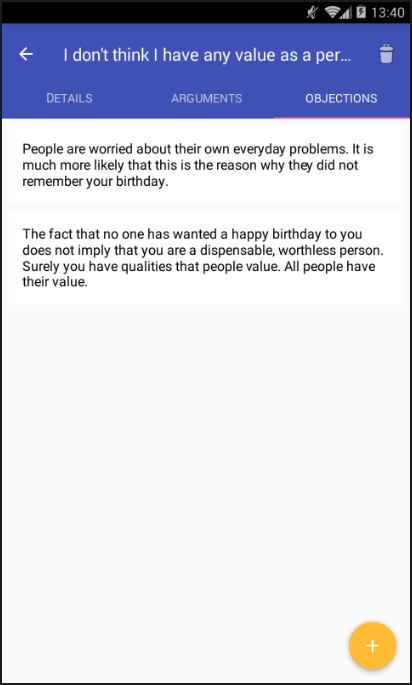
Next, you will be able to observe the arguments and objections of each belief.
Belief: I don't think I have any value as a person.
Arguments
>>> No one gave me a happy birthday, so I must be a dispensable person.
Objections
>>> The fact that no one has wanted a happy birthday to you does not imply that you are a dispensable, worthless person. Surely you have qualities that people value. All people have their value.
>>> People are worried about their own everyday problems. It is much more likely that this is the reason why they did not remember your birthday.
Belief: Nobody cares about me.
Arguments
>>> Since no one wished me a happy birthday, no one should care about me.
Objections
>>> You think you know what others think and feel about you, but that is impossible. People often have difficulty expressing their feelings, so someone you think does not care about you can care a lot.
>>> People are worried about their own everyday problems. It is much more likely that this is the reason why they did not remember your birthday.
Belief: I must be a boring and unbearable person.
Arguments
>>> In the past, while I was talking to a friend at work, he yawned. So I must be a boring person.
>>> No one wanted to wish me a happy birthday because they did not want to start a conversation with me and get bored with me.
Objections
>>> Probably people did not wish you a happy birthday because they were busy with their lives, facing the problems of the day-to-day that we all have. It is impossible to conclude that this is 100% your fault.
>>> The fact that people get bored with a single conversation with me does not mean that I am a boring person, since I can talk about other subjects.
Belief: Nobody likes me.
Arguments
>>> Since no one wished me a happy birthday, no one should likes me.
Objections
>>> You think you know what others think and feel about you, but that is impossible. People often have difficulty expressing their feelings, so someone you think does not likes you can like a lot.
>>> People are worried about their own everyday problems. It is much more likely that this is the reason why they did not remember your birthday.